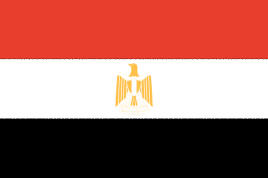 |
 |
Egypt/Italy Tour 2003: Wednesday, 16 April 2003
Overnight flight
Woke at 4.30 a.m. to find ourselves 400 miles south of Cairo (according to the very useful flight information screens). It was still dark outside but dawn's rosy fingers were just beginning to caress our fuselage!
We are all carrying 3 litres of water in our hand luggage - an immense weight - but it is needed for Cairo today.
By 4.43 a.m. dawn was definitely coming up on the starboard side. We landed at 5.17 a.m. A very smooth flight. Outside the atmosphere looked very misty - due to dust? The light was still the dim light of dawn with artificial lights on generally. The temperature was 14 degrees C.
We cleared immigration and customs and emerged into a cool, even slightly chilly, Cairo morning and boarded a bus for our day hotel. At 6.59 a.m. we crossed the Nile. The following picture shows the scene - note the haziness of the weather.
Initial impressions of Cairo were of a sprawling, mainly low-rise, bustling, middle eastern city consisting of substantial houses, possibly blocks of flats; arabic everywhere with some english signs. Even arabic-style music playing on the bus to add atmosphere. Some familiar plants: bougainvilleas, casuarinas, Melia azedarach, Bauhinia variegata, figs, palms, some pinnate-leaved legume I don't know ... Driving is on the right. Everything is very dry and the atmosphere very hazy.
Cataract Pyramids Resort
As we arrived at the hotel it suddenly occurred to me that we had a police escort. I understand that these are the tourist police, but their presence has nothing to do with the current middle eastern situation.
The next 4 pictures show the group waiting in the foyer of the Cataract Pyramids Hotel while Corrado made arrangements for the day rooms to be allocated.
We then walked through the grounds of the Hotel to our rooms.
Pyramids at Giza
Later that morning we boarded the bus to visit the Pyramids at Giza. Here, Ashraf our guide gives us information about what we are about to see.
The first batch of pictures (numbered 10 to 21 inclusive) were taken at the Giza Plateau adjacent to the Great Pyramid of Khufu (Cheops). Those numbered 22 to 33 inclusive were taken in an underground tomb nearby.
It is difficult, when one is so close to the Great Pyramid, to convey in pictures its size and scale. However, all 3 pyramids are most impressive and this was a great start to our visit to Egypt.
There are estimated to be 2.3 million blocks used in the construction of the Great Pyramid, each weighing 5-12 tons. As may be seen the size of the bottom row is quite large - perhaps about 1.5 m high. The Pyramid itself is 146 metres high.
Image 11 shows a view straight up the side; 13: Ashraf talks to some of the group; 14: some of the group up near the entrance; 15: view at the bottom showing the reconstructed limestone facade.
16: Solar barque with camel behind on right. Images 17 to 20 show more pictures of the group on the Giza Plateau.
Image 21 shows the group with Cairo in the distance behind. Note how the plateau is raised slightly above the level of the city.
Images 22 to 28 inclusive show various people entering a subterranean tomb. They are: 22: Andrew (at the front); 23: Robin Brighton (Andrew behind); 24: Barry Brighton and Shaan Grayling; 25: Linda; 26: Vanessa Francis; 27: Liz Hinde; 28: Tony Francis.
Images 29 and 30 show two details from the tomb; 31 and 32 various people on the tour (including me with my black desk diary) and 33 details of a funerary procession.
We then moved away from the Great Pyramid towards the very slightly smaller pyramid which still bears part of its covering as a cap. This is the Pyramid of Khefren. Image 34 shows us on the way. One of the extraordinary things about this area is the complete absence of plant life at all - it is like walking on a beach. Here too there were some fairly persistent sellers, but polite refusals seemed to work in the end. Image 35 shows the pyramid with the Museum of the Solar Barque on the right and 36 shows the pyramid with some of the group in front.
Finally we rather briefly looked at the smallest of the 3, the Pyramid of Menkaure (Mycerinus).
First commercial break
Back on the bus for a touristy interlude at the Aquamarine bazaar.
The Sphinx
Images 41 to 49 show either the Sphinx with various pyramids behind or are pictures taken at the nearby temple. The Sphinx itself is 20 m high and 54 m long; the head dress worn appears to be that of a cobra.
Second commercial break
This was a visit to a shop which sold perfumes.
After this we returned to the hotel and our rooms and some managed to catch up on some sleep. At about 8 p.m. we boarded our buses and were driven to Giza Railway station. The driving in Cairo is quite amazing with little lane discipline and continual hooting and cutting in the norm. However, we saw few accidents so perhaps it is a system that works.
There we had a long wait on the platform for the train to Aswan. Corrado had given us various dire warnings about security but neither on our arrival nor during the long wait were there any problems; everything was calm and orderly and we had our usual security escort.
The carriages themselves were bitterly cold. I heard Robert telling the old joke from "I'm Sorry I'll read that again", which goes like this: Passenger on train to railway guard: "There's something wrong with the heating!" Guard: "Is it too hot?" "No." Is it too cold?" "No." Guard: "You're quite right, there is something wrong with it!".
Apart from the temperature, which we were able partly to solve, the train was comfortable with reasonable amounts of space. Like Zimbabwean trains the speed is slow. It takes 13 hours to get to Aswan which I believe is 600 kms away.
This has been a great first day: as one can tell from the 17 pages of diary used up.


















































